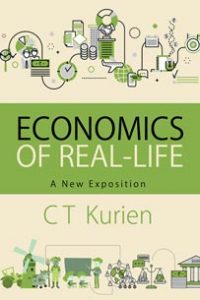On Kurien’s new book, Economics of Real-Life
Download the WEA commentaries issue ›
By Stuart Birks

CT Kurien is still active, despite his advanced years and failing eyesight. His latest book is Economics of Real-Life: An Exposition*. It is deceptively simple in exposition, given that it is based on a depth of knowledge. Step by step, the reader is led through an alternative way of looking at an economy, building from the simplest of communities to, by the end of the book, a global economy. In doing so, he deviates from the mainstream division of the economy into households and firms, identifying instead nine different units and the links between them.
As with his earlier Wealth and Illfare, Kurien uses thought experiments to build an understanding of the evolution of economic relationships. In this book, the structure is more developed, with a more nuanced structure than the mainstream distinction of households and firms. Households can be involved in production as well as consumption, and they are not homogeneous. For example, households can be labour poor, subject to a labour constraint (e.g. landowners), or capital poor, subject to a resource constraint (e.g. landless labourers). Consequently specialisation of roles and imbalances of negotiating power can be considered.
Kurien notes that economic relationships tend to get ‘institutionalised’, thereby providing a sense of stability. Study of such institutions, therefore, forms an important part of economics. Ownership is a matter of social relationships. Traders are seen as an important determinant of the structure and evolution of an economy, and with their arrival “production increasingly becomes a specialised activity and the space between the producer and the consumer widens” (p.116). Even in production, there are intermediate goods, many of which are allocated through markets. Wherever there are markets, there are merchants, so the producer-consumer link is generally by no means direct. A nuanced view of society and its economic dimension can be developed through a focus on ownership, authority, intermediation and asymmetry of information. As intermediaries and knowledge asymmetries are important, social structures evolve, resulting from and enhancing differences. In addition, the importance of authority in decision making indicates that economics and politics are interrelated.
Kurien identifies the cherry picking of Adam Smith that can be found in modern mainstream texts. While self-interest may be a motivator, Smith also recognises (at the same point in his Wealth of Nations) the need for co-operation, saying of man, “In civilised society he stands at all times in need of the co-operation and assistance of great multitudes”. Kurien also notes the misrepresentation of Smith’s reference to the “invisible hand”.
Rather than consumer sovereignty, Kurien notes the importance of consumer manipulation (through advertising, etc.). Similarly shareholding results in capitalist ownership being a form of “fleeting ownership”. Finance also sees the growth of “proxy wealth”, “a claim on physical wealth that can easily be transacted, unlike physical forms of wealth” (p.98). This can cause problems, “creation and possession of proxy wealth can easily become substitutes for increasing real wealth. Finance then becomes the agency for this aberration.” There can be extreme economic and social consequences of this development. Kurien’s discussion of the government’s supervisory powers encapsulates some strong arguments as to why we should not really think of the being a “market economy” independent of government.
Kurien sees his Chapter 9 as key to the book. Tt presents a clear description of his analytical structure. The economy can be seen as a network of participants and activities, units and links. These result in nine different types in his table on p.117. There are not only various types of households and economic units such as firms and banks, but also traders are separately identified. “If multilateral exchange is one of the main links in a modern economy drawing in practically all its different units into interaction, the role of the trader cannot be minimised” (p.121). In addition, he expressly states that the economy is “always in a state of flux”, challenging the perspectives that focus on equilibrium.
As a further step away from economics based on perfect competition and closer to reality, “most markets are controlled by a few producer-trader combines that can easily fix prices” (p.134). How suited is mainstream economics for guiding policy in such situations?
Chapter 12 covers the emergence of MNCs. It presents a broad sweep of global world economic events since WWII.
Later chapters contain an interesting brief description of events in the Indian economy, especially since independence, plus some further speculation on policy issues and possible future development paths.
While aimed primarily at an Indian audience, you should not be put off by that. It is a worthwhile read for those with an interest in economics more generally. Central to the book is the view that economies are always changing, and so economics must adapt also to be relevant to the country and time under consideration. Consequently there is a need for ‘substantive logic’ based on the nature of the problem under consideration, rather than internally logically consistent axiomatic approaches.
The framework is one that allows for multidisciplinary analysis and highlights the limitations of a mainstream economics perspective. These are, in particular, the mainstream emphasis on equilibrium, its reliance on its own concept of a utopian economy, the artificial distinction between a market economy and the political system and public sector.
* Kurien, C. T. (2018). Economics of Real-Life: A New Exposition. New Delhi: Academic Foundation.
From: pp.7-8 of WEA Commentaries 8(2), April 2018
https://www.worldeconomicsassociation.org/files/Issue8-2.pdf